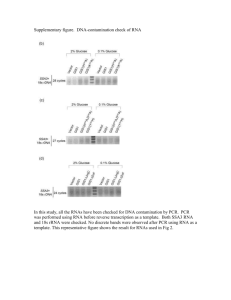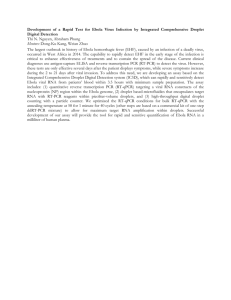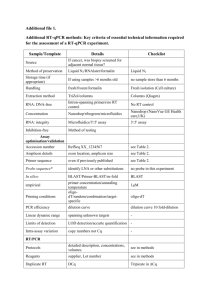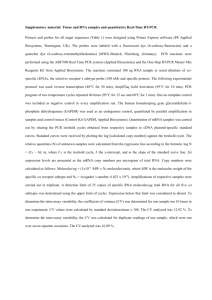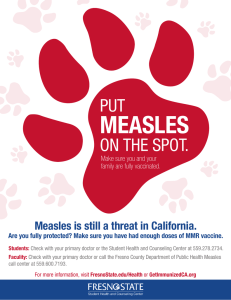RT-qPCR and molecular diagnostics: no evidence for
advertisement
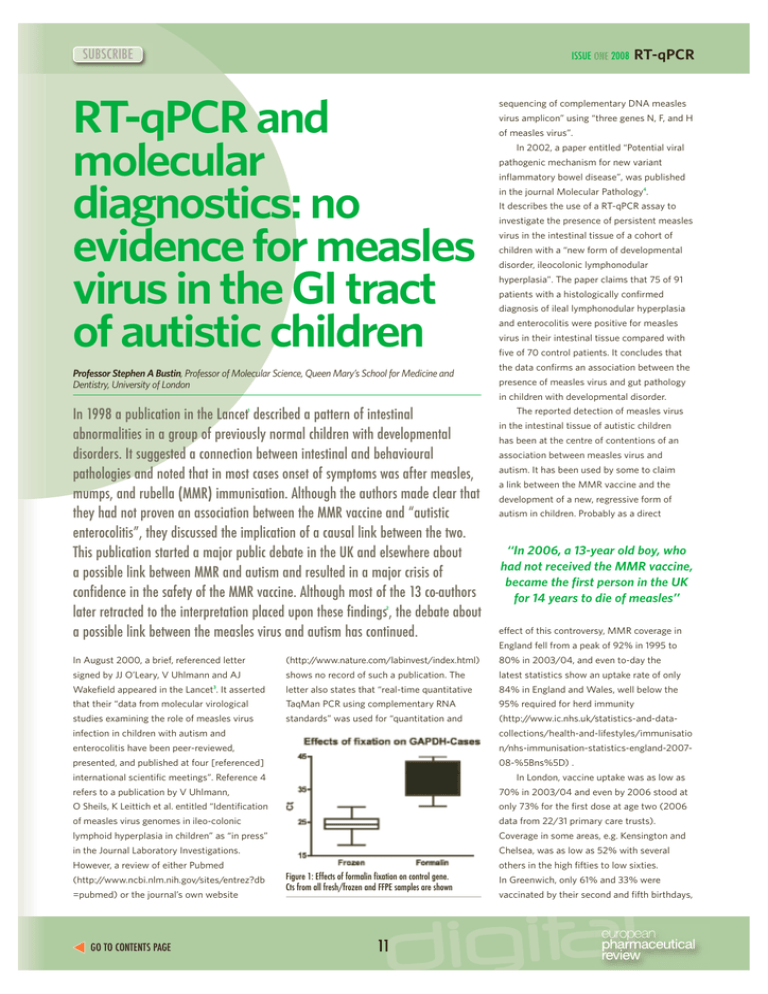
SUBSCRIBE ISSUE RT-qPCR and molecular diagnostics: no evidence for measles virus in the GI tract of autistic children Professor Stephen A Bustin, Professor of Molecular Science, Queen Mary’s School for Medicine and Dentistry, University of London 2008 RT-qPCR sequencing of complementary DNA measles virus amplicon” using “three genes N, F, and H of measles virus”. In 2002, a paper entitled “Potential viral pathogenic mechanism for new variant inflammatory bowel disease”, was published in the journal Molecular Pathology4. It describes the use of a RT-qPCR assay to investigate the presence of persistent measles virus in the intestinal tissue of a cohort of children with a “new form of developmental disorder, ileocolonic lymphonodular hyperplasia”. The paper claims that 75 of 91 patients with a histologically confirmed diagnosis of ileal lymphonodular hyperplasia and enterocolitis were positive for measles virus in their intestinal tissue compared with five of 70 control patients. It concludes that the data confirms an association between the presence of measles virus and gut pathology in children with developmental disorder. In 1998 a publication in the Lancet described a pattern of intestinal abnormalities in a group of previously normal children with developmental disorders. It suggested a connection between intestinal and behavioural pathologies and noted that in most cases onset of symptoms was after measles, mumps, and rubella (MMR) immunisation. Although the authors made clear that they had not proven an association between the MMR vaccine and “autistic enterocolitis”, they discussed the implication of a causal link between the two. This publication started a major public debate in the UK and elsewhere about a possible link between MMR and autism and resulted in a major crisis of confidence in the safety of the MMR vaccine. Although most of the 13 co-authors later retracted to the interpretation placed upon these findings , the debate about a possible link between the measles virus and autism has continued. 1 The reported detection of measles virus in the intestinal tissue of autistic children has been at the centre of contentions of an association between measles virus and autism. It has been used by some to claim a link between the MMR vaccine and the development of a new, regressive form of autism in children. Probably as a direct ‘‘In 2006, a 13-year old boy, who had not received the MMR vaccine, became the first person in the UK for 14 years to die of measles’’ 2 effect of this controversy, MMR coverage in England fell from a peak of 92% in 1995 to In August 2000, a brief, referenced letter (http://www.nature.com/labinvest/index.html) 80% in 2003/04, and even to-day the signed by JJ O’Leary, V Uhlmann and AJ shows no record of such a publication. The latest statistics show an uptake rate of only Wakefield appeared in the Lancet3. It asserted letter also states that “real-time quantitative 84% in England and Wales, well below the that their “data from molecular virological TaqMan PCR using complementary RNA 95% required for herd immunity studies examining the role of measles virus standards” was used for “quantitation and (http://www.ic.nhs.uk/statistics-and-data- infection in children with autism and collections/health-and-lifestyles/immunisatio enterocolitis have been peer-reviewed, n/nhs-immunisation-statistics-england-2007- presented, and published at four [referenced] 08-%5Bns%5D) . international scientific meetings”. Reference 4 In London, vaccine uptake was as low as refers to a publication by V Uhlmann, 70% in 2003/04 and even by 2006 stood at O Sheils, K Leittich et al. entitled “Identification only 73% for the first dose at age two (2006 of measles virus genomes in ileo-colonic data from 22/31 primary care trusts). lymphoid hyperplasia in children” as “in press” Coverage in some areas, e.g. Kensington and in the Journal Laboratory Investigations. Chelsea, was as low as 52% with several However, a review of either Pubmed (http://www.ncbi.nlm.nih.gov/sites/entrez?db =pubmed) or the journal’s own website GO TO CONTENTS PAGE others in the high fifties to low sixties. Figure 1: Effects of formalin fixation on control gene. Cts from all fresh/frozen and FFPE samples are shown 11 In Greenwich, only 61% and 33% were vaccinated by their second and fifth birthdays, RT-qPCR ISSUE SUBSCRIBE 2008 respectively. In 2006, a 13-year old boy, who America), GI disease, recency of MMR product permits accurate quantification of had not received the MMR vaccine, became vaccine administration at time of biopsy, and target molecules over a wide dynamic range the first person in the UK for 14 years to methods for confirming neuropsychiatric in the presence of suitable standards. die of measles. status in cases and controls.” There have been a number of studies On 11 June 2007, the first of The consistency and reliability of RT-qPCR assays depends on the appropriate execution attempting to reproduce the findings of approximately 4,800 cases in the US omnibus of a number of steps, principally those the paper originating from JJ O’Leary’s autism proceedings came to trial at the United involving sample selection, template quality, laboratory5-7. All failed to do so; instead they States Court of Federal Claims, where all assay design and data analysis11. In practice, provided strong evidence for contamination vaccine claims are managed and adjudicated the quality of any data obtained using the being the cause of the positive findings by the congressionally created Office of RT-qPCR assay is affected by the integrity reported by Ulmann et al. However, there Special Masters. The trials are designed to of the RNA template, the choice of cDNA were some technical differences between the establish whether or not autism can be priming strategy and reverse transcriptase, original study and the three more recent ones caused by thimerosal containing vaccines, by the characteristics of the primers and the in the choice of tissue (gut vs. blood) or MMR vaccine, or a combination of the two. validity of the normalisation method12-18. Not On 6 June, the UK High Court gave surprisingly, the universal dissemination of protocols (enzymes, real-time PCR permission for the release to the US Secretary this technology has led to the development of the Department of Health and Human of numerous, individual experimental Services of two reports authored by the author protocols that can affect data (Stephen Bustin). These documents were filed by the three principal defendants in the UK ‘‘The use of fluorescent reporter molecules permits concurrent target amplification, detection and quantification as the assay proceeds’’ MMR vaccine litigation. They constitute an exhaustive analysis of raw TaqMan data underlying the results reported by the Uhlmann paper that were generated at the Figure 2: Effects of formalin fixation on F-gene. Cts from samples that tested positive for F-gene are shown for fresh/frozen and FFPE laboratory of Unigenetics Ltd at Coombe Women's Hospital in Dublin by Professor O’Leary’s team, which included Dr Sheils. On 20 June, the evidence contained in reproducibility19,20. The resulting potential for uncertainty has increased the awareness of chemistries). Therefore, whilst there was these reports was presented to the trial, and a need for common guidelines, in particular a strong suggestion that Prof O’Leary’s this communication outlines the major those relating to quality assessment of every laboratory was detecting contaminants, there conclusions and is based upon the publicly component of the RT-qPCR assay and was no proof. This has now changed with available transcript from the autism omnibus appropriate data analysis11. This clear a recent publication, which includes Prof proceedings (ftp://autism.uscfc.uscourts.gov/ requirement for improved consistency of gene O’Leary and Dr Sheils, that has used the same autism/transcripts/day08.pdf). expression measurements is particularly methods, inter alia, as those originally relevant in relation to human clinical published, to come to the conclusion that Real-time RT-PCR there is indeed no link between measles virus The RT-qPCR assay consists of a reverse vaccine, autism and enteropathy8. transcription step that converts RNA into Analysis of the published “Uhlmann” paper Astonishingly, there is no attempt to retract DNA, followed by the real-time PCR segment, The results presented in this paper4 are at the original report, and the admission that which specifically amplifies the target gene(s) the core of most hypotheses linking measles these results are in direct contradiction of of interest. The use of fluorescent reporter virus and autism. Consequently it is essential the previously reported ones are thoroughly molecules permits concurrent target to consider the main criticisms of the disingenuous: “Our results differ with [their amplification, detection and quantification as published evidence: own] reports noting MV RNA in ileal biopsies the assay proceeds . Increases in fluorescent 1. of 75% of ASD vs. 6% of control children signal are proportional to the amount of DNA frozen biopsies as well as formalin fixed [10,41]. Discrepancies are unlikely to produced during each PCR cycle and produce paraffin-embedded tissue (FFPE). represent differences in experimental characteristic threshold cycles (Ct) for every Formalin fixation is used to preserve technique because similar primer and probe reaction. The Ct is defined as the PCR cycle tissue morphology without regard for sequences, cycling conditions and instruments fraction at which the signal first rises above RNA preservation. It is well established were employed in this and earlier reports; instrument background fluorescence. As a that this process modifies and destroys furthermore, one of the three laboratories result, the more initial targets, the sooner the RNA, or in Prof O’Leary’s own evidence participating in this study performed the instrument can detect the fluorescence and “wax and fixation by itself breaks down assays described in earlier reports. Other the lower the Ct. Conversely, a higher Ct RNA”24. This makes it less accessible for factors to consider include differences in denotes less initial target. This correlation amplification compared with RNA from patient age, sex, origin (Europe vs. North between fluorescence and amount of amplified fresh samples and results in an increased diagnostic assays21-23. 9,10 12 Total RNA was extracted from fresh www.europeanpharmaceuticalreview.com RT-qPCR ISSUE 2008 4. As with any biochemical assay, RT-qPCR Figure 3: Comparison of F-gene Cts from degraded and nondegraded RNA One purpose of reporting results in the experiments use standards that permit scientific literature is to provide sufficient the calculation of target RNA copy information to allow any competent scientist numbers, PCR amplification efficiencies to repeat that experiment. This requires and assay sensitivity and linearity. Ideally detailed publication of the protocol. In they should be included with every addition, any conclusions must be supported assay12,13. The paper mentions standards, by data and it is unacceptable to summarise but does not provide any of the crucial results without any relevant information as to information about what their use how those were obtained. At the very revealed with respect to the quality of minimum, standard curve data and copy the RT-qPCR assay. number data for F and H genes should have 5. Although the paper describes a number been published. The standard curve data of controls, it omits the elementary would allow the reader to assess the quality one of leaving out the RT-step and adding of the assay, and concordance between viral Ct for FFPE samples that is variable and the RNA directly to a PCR assay. This is F and H gene results would make the data assay-dependent25. The significant required to discriminate amplification more convincing, since they would act as qualitative differences between the RNAs of RNA from that of a DNA target: independent internal controls of one another. make it inappropriate to compare directly if positive, the target must be a any RT-qPCR results26. Since the Uhlmann contaminating DNA. Since MV has no paper provides no information as to DNA stage in its life cycle, inclusion of Analysis of the raw TaqMan data underlying the “Uhlmann” paper whether the same proportion of this control is absolutely essential. The transcript of the detailed criticisms of the fresh/frozen and FFPE samples were As the assay uses Tth polymerase, work underlying this paper is available online used for patients and controls, it is not this control should have consisted of (ftp://autism.uscfc.uscourts.gov/autism/trans possible to gauge the reliability of the either leaving out the RT step or using cripts/day08.pdf) and addresses all of the RT-qPCR data. Taq polymerase, which is a poor above points. The purpose of this RNA-dependent DNA-polymerase. communication is to highlight the two key 2. There is no information as to how the lines of reasoning that prove with the highest fresh samples were frozen or how long they had been stored. No quantification or ‘‘Since MV has no DNA stage in its life cycle, inclusion of this control is absolutely essential’’ quality assessment of the extracted RNA is provided; indeed there is no mention of RNA quality. This is vital information laboratory was detecting contaminants, and that these contaminants were DNA. This is a decisive finding, since MV does not exist in DNA form. Hence the assay cannot be needed to assess the validity of any quantitative or negative result21. degree of certainty that Prof O’Leary’s 6. The TaqMan results are summarised 3. A quantitative comparison of RT-qPCR detecting MV and, in the absence of this without providing any actual data. Simply bedrock evidence, any proposed link between data from different individuals requires stating 70/91 positive in group A and measles virus, MMR and autism is the inclusion of a gene dosage 4/70 in group B is meaningless. The demonstrably unsustainable. compensation (or “normalisation”) step. whole point of a TaqMan assay is to This involves the separate amplification provide quantitative data. The TaqMan examining the data from every single sample and quantification of internal reference methods refer to MV F, and H genes, but from all 91 RT-qPCR runs disclosed by (or “housekeeping”) genes, and there is no mention of any concordance in Unigenetics. This involved using identical expressing gene-of-interest copy numbers the results section of the paper. If genuine, sequence detection software (SDS) and relative to those of the reference genes. results from all three genes should have versions thereof, to process the disclosed The authors mention gene dosage been similar. Since the abstract claims correction, but give no indication of what to have quantitated both F and H they actually did. Furthermore, they used genes, it is unusual that the results were a single gene only, GAPDH, as their reference gene. Normalisation using a This conclusion was reached after not included. 7. MV copy numbers in the affected children single reference gene, and GAPDH in are reported as ranging from 1 to 3x105 particular, is not reliable due to the copies of RNA/ng total RNA; no significant variation in its expression corresponding figure is provided for the between and even within individuals27. 4/26 positive samples from the control Since the performance of the RT-PCR samples. In addition, there is no assay is crucial to accurate quantification, information on how that copy number information with respect to the GAPDH was obtained and on whether replicates assay should have been provided. were run and gave concordant results. 14 Figure 4: F-gene standard curves. On 11/04/01 the RT step was included, on 19/06/01 it was omitted www.europeanpharmaceuticalreview.com SUBSCRIBE ISSUE RT-qPCR Since any nucleic acid present during procedure and noted where the different operators did not adhere to the set protocols. formalin fixation would have been affected in an identical manner, the obvious implication “Uhlmann” is detecting contamination Figure 5: Similar Cts with and without reverse transcription. Comparative Cts for the F-gene from RNA subjected to an RT step, followed by a PCR (all cases) and RNA subjected only to a PCR step (no RT) 2008 of these results is that the GAPDH target was RNA was extracted from both fresh/frozen present prior to formalin fixation, whereas the and FFPE tissue samples and subjected to F-gene target entered the sample after RT-qPCR analysis of a reference gene, formalin fixation. Consequently, the F-gene GAPDH, as well as the MV F-gene. The assay is detecting a contaminant. The finding expectation was that the average Ct for both of F-gene amplification in approximately one would be significantly higher in the FFPE third of F-gene no template (negative) samples. Indeed, for GAPDH mRNA there controls supports this conclusion. was an average difference of just over nine Cts between fresh/frozen and FFPE samples, The contaminant is DNA (1) TaqMan files and generate new experimental corresponding to an approximate 500-fold Quantification of an internal reference mRNA reports. These were compared with those difference in mRNA levels. is useful as a rough guide to RNA quality: disclosed by Prof O’Leary’s laboratory and any absence of amplification suggests degradation differences were noted. Any ambiguous or or lack of RNA and allows exclusion of such ‘‘Quantification of an internal reference mRNA is useful as a rough guide to RNA quality’’ discordant results and all results involving negative controls were further investigated by scrutinising the raw data collected by the instrument. This involved an examination of samples from further analysis. Again, the expectation was that any GAPDH -ve sample would also be negative for the MV F-gene. Fortuitously from the investigator’s point of nearly 700 data points per well and permitted view and against the guidelines of their own This result provided a convenient control a definitive resolution of all ambiguities. SOP, the authors did not discard all GAPDH I also read the disclosed experimental reports, for the MV F-gene assay, with the expectation -ve samples. Instead, they reported positive operator sheets and laboratory notebook of a similar ∆Ct between the two sample MV F-gene results in several GAPDH -ve entries relevant to the RT-qPCR assay. types. Unexpectedly, the F-gene Cts recorded autistic patient samples. Implausibly, the I compared these with the data obtained from for RNA extracted from fresh/frozen and FFPE average Ct recorded for the F-gene from these every run. I examined the standard operating samples were approximately the same. samples was 3 Cts lower than that recorded HotStart-IT. Less Heat. No DNA Damage. We couldn’t be more specific. ® USB’s novel hot start PCR method requires no extensive heat denaturation step. The result is no damage to precious samples with increased specificity and yield. HotStart-IT® Taq DNA Polymerase • Based on primer sequestration–a novel method developed by USB scientists • Unique protein binds primers to prevent mispriming • Primers are released during heat denaturation Real-time PCR from 108 copies down to a single copy target using HotStart-IT® 1 ng DNA Increased specificity of HotStart-IT® Taq DNA Polymerase Results clearly demonstrate a shift from predominantly primer-dimers to the specific target when HotStart-IT® is included in the reactions. M without HotStart-IT – – Benefits High Sensitivity • Detects <10 target copies • Linear dynamic range of 7–8 orders of magnitude, R2 ≥ 0.95 Ease of Use • Multiple instrument compatibility for real-time PCR with HotStart-IT + + 108 numb, 306 bp primer-dimers For more information on HotStart-IT® call: +49(0)76 33-933 40 0 or visit www.usbweb.de/hotstart 106 104 102 1 RT-qPCR ISSUE 2008 for GAPDH +ve samples, implying an eight- widespread contamination with F-gene DNA. MMR vaccination during the routine fold higher abundance of F-gene target (see As a result there is no credible evidence for childhood immunization schedule of UK. J Figure 2 on page 12). Since, by definition, these the presence of either MV genomic RNA or samples do not contain amplifiable RNA, the mRNA in the GI tracts (or blood samples) of PCR must be detecting contaminating DNA. any patient investigated by this laboratory. Ward BJ. No evidence of persisting measles Consequently, this finding excludes any link virus in the intestinal tissues of patients with between MV and, by extension, the MMR inflammatory bowel disease. Gut The contaminant is DNA (2) The inference that the O’Leary assay is vaccine and autism. 2007;56(6):886-8. detecting DNA is backed by the chance 7. discovery that two RT-PCR runs, one for the have accidentally omitted the reverse transcription step. Ironically, this constitutes the negative control referred to above and, D'Souza Y, Fombonne E, Ward BJ. No evidence of persisting measles ‘‘Opportunely, the F-gene run of 19/06/01 contained four autistic patient samples’’ GAPDH gene the other for the MV F-gene, if positive, proves that the amplified target is Med Virol 2006;78(5):623-30. 6. D'Souza Y, Dionne S, Seidman EG, Bitton A, virus in peripheral blood mononuclear cells from children with autism spectrum disorder. Pediatrics 2006;118(4):1664-75. 8. Hornig M, Briese T, Buie T, Bauman ML, Lauwers G, Siemetzki U, et al. Lack of DNA, not RNA. Prof O’Leary used cRNA to Acknowledgement generate standard curves for both the GAPDH This work was carried out for the MMR vaccine and autism with enteropathy: and MV F-gene assays. A comparison of two vaccine litigation trial at the High Court of a case-control study. PLoS ONE F-gene standard curve runs, one carried out in Justice in London. The author acted as an the presence of the RT step (11/04/01), the expert witness and was paid by the solicitors other in its absence (19/06/01), clearly shows acting for the principal defendants SmithKline Simultaneous amplification and detection of the effect of the omitted RT. Beecham Plc and Smith Kline & French specific DNA sequences. Biotechnology Laboratories Ltd, Merck & Co Inc and Sanofi (N.Y.) 1992;10(4):413-17. The ∆Ct is around eight, corresponding association between measles virus 2008;3(9):e3140. 9. Higuchi R, Dollinger G, Walsh PS, Griffith R. to an approximate 250-fold difference in Pasteur MSD Ltd. The author also acted as apparent abundance; the results from the an expert witness for the US Department of Kinetic PCR analysis: real-time monitoring of RT-qPCR assay targeting GAPDH are similar. Justice. A witness has a simple, clear duty DNA amplification reactions. Biotechnology These results are as expected: omission of the to assist the court, which overrides any obligation to the person from whom he has received instruction or payment. Analyses and ‘‘These data provide incontrovertible evidence that the target detected by Prof O’Leary’s laboratory is DNA, not RNA’’ conclusions are based on his qualifications and experience alone. (NY) 1993;11(9):1026-30. 11. Nolan T, Hands RE, Bustin SA. Quantification of mRNA using real-time RT-PCR. Nature Protocols 2006;1(3):1559-82. 12. Bustin SA. Absolute quantification of mRNA using real-time reverse transcription References 1. 10. Higuchi R, Fockler C, Dollinger G, Watson R. polymerase chain reaction assays. J. Mol. Wakefield AJ, Murch SH, Anthony A, Linnell J, Casson DM, Malik M, et al. Ileal- Endocrinol. 2000;25(2):169-93. 13. Bustin SA. Quantification of mRNA using RT-step results in inefficient reverse lymphoid-nodular hyperplasia, non-specific real-time reverse transcription PCR (RT- transcription of the GAPDH and MV F-gene colitis, and pervasive developmental PCR): trends and problems. J. Mol. cRNA standards, as well as GAPDH mRNA. disorder in children. Lancet 1998;351(9103):637-41. Opportunely, the F-gene run of 19/06/01 Murch SH, Anthony A, Casson DH, Malik M, real-time reverse-transcription polymerase All four recorded positive Cts that, against Berelowitz M, Dhillon AP, et al. Retraction of chain reaction. J Biomol Tech expectation, were in a similar range to most an interpretation. Lancet of the F-gene Cts recorded from runs that 2004;363(9411):750. contained four autistic patient samples. included the RT step. 2. Endocrinol 2002;29(1):23-39. 14. Bustin SA, Nolan T. Pitfalls of quantitative 3. These data provide incontrovertible evidence that the target detected by Prof O’Leary’s laboratory is DNA, not RNA. 2004;15(3):155-66. 15. Tricarico C, Pinzani P, Bianchi S, Paglierani O'Leary JJ, Uhlmann V, Wakefield AJ. M, Distante V, Pazzagli M, et al. Measles virus and autism. Lancet Quantitative real-time reverse 2000;356(9231):772. transcription polymerase chain reaction: 4. Uhlmann V, Martin CM, Sheils O, Pilkington normalization to rRNA or single Since MV does not pass through a DNA L, Silva I, Killalea A, et al. Potential viral housekeeping genes is inappropriate for stage during its life cycle, the assay cannot pathogenic mechanism for new variant human tissue biopsies. Anal. Biochem. be detecting MV. inflammatory bowel disease. Mol Pathol Conclusion 2002;55(2):84-90. 5. 2002;309(2):293-300. 16. Huggett J, Dheda K, Bustin S, Zumla A. Real- Afzal MA, Ozoemena LC, O'Hare A, Kidger time RT-PCR normalisation; strategies and This exhaustive analysis of the experimental KA, Bentley ML, Minor PD. Absence of considerations. Genes Immun RT-qPCR data generated by the Unigenetics detectable measles virus genome sequence in laboratory demonstrates persistent and blood of autistic children who have had their 16 2005;6(4):279-84. 17. Dheda K, Huggett JF, Chang JS, Kim LU, www.europeanpharmaceuticalreview.com SUBSCRIBE ISSUE Bustin SA, Johnson MA, et al. The diagnostics: putting the cart before implications of using an inappropriate the horse. Biomarkers in Medicine reference gene for real-time reverse transcription PCR data normalization. Anal Biochem 2005;344(1):141-3. 18. Dheda K, Huggett JF, Bustin SA, Johnson MA, Rook G, Zumla A. Validation of housekeeping genes for normalizing RNA 2008 RT-qPCR 2008;2:201-07. 24. O'Leary JJ. House of Representatives, Committee on Government Reform. 106th Cong., 2nd Sess 2000;Serial No. 106180:123-37. 25. Koch I, Slotta-Huspenina J, Hollweck expression in real-time PCR. Biotechniques R, Anastasov N, Hofler H, Quintanilla- Stephen Bustin 2004;37(1):112-19. Martinez L, et al. Real-time quantitative Stephen Bustin obtained his PhD from Trinity College, University of Dublin in molecular genetics. Since 1989 he has worked at the Royal London Hospital, aiming to apply his research in a more direct, practical setting. Following promotion to Senior Lecturer (1995) and Reader in Molecular Medicine (2002) he was awarded a personal chair by the University of London in 2004. He was appointed as a visiting Professor of Molecular Biology by the University of Middlesex in 2006. 19. Bustin SA. Real-time, fluorescence-based RT-PCR shows variable, assay-dependent quantitative PCR: a snapshot of current sensitivity to formalin fixation: procedures and preferences. Expert Rev Mol implications for direct comparison of Diagn 2005;5(4):493-8. transcript levels in paraffin-embedded 20. Bustin SA, Benes V, Nolan T, Pfaffl MW. Quantitative real-time RT-PCR--a perspective. J Mol Endocrinol 2005;34(3):597-601. 21. Bustin SA, Mueller R. Real-time reverse tissues. Diagn Mol Pathol 2006; 15(3):149-56. 26. von Smolinski D, Leverkoehne I, von SamsonHimmelstjerna G, Gruber AD. Impact of formalin-fixation and paraffin-embedding on transcription PCR (qRT-PCR) and its the ratio between mRNA copy numbers of potential use in clinical diagnosis. Clin Sci differently expressed genes. Histochem. Cell (Lond) 2005;109(4):365-79. 22. Bustin SA, Mueller R. Real-time reverse Biol. 2005;124(2):177-88. 27. Vandesompele J, De Preter K, Pattyn F, Poppe transcription PCR and the detection of occult B, Van Roy N, De Paepe A, et al. Accurate disease in colorectal cancer. Mol. Aspects normalization of real-time quantitative RT- Med. 2006;27:192-223. PCR data by geometric averaging of multiple 23. Bustin S. Molecular medicine, gene-expression profiling and molecular internal control genes. Genome Biol 2002;3(7):0034.1-34.11. His main area of research is into bowelassociated pathologies, especially colorectal cancer and, more recently, Clostridium difficile-associated disease. He has a special interest in molecular technologies and his laboratory operates at the forefront of technological development in nucleic acid quantification, where he is an internationally acknowledged leader. He has given numerous presentations at scientific conferences around the world. He has organised and co-organised many qPCR meetings in the UK, Europe and the US.
